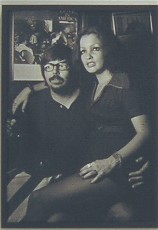
My other primary goal in New York Wednesday afternoon was seeing William Eggleston’s “Nightclub Portraits” at Cheim & Read. After seeing his beautiful little color landscapes and townscapes in the Mavericks of Color show at the Philadelphia Museum of Art (see posts here and here), I was interested in seeing his portraits.
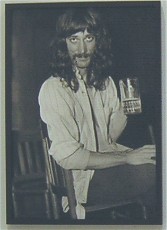
After too many severe Diane Arbus portraits, Eggleston comes as a relief. He loves his subjects and captures their individuality.
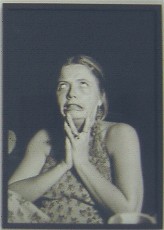
The lighting is luminous in these black-and-white photographs, for which he used an umbrella to light up the faces in the dark nightclub. Unfortunately, my pictures of his pictures are anything but luminous.
Of course, because of the nightclub setting, the 1973 portraits make me think of Sarah Stolfa’s hot-off-the-press bar-patron full-color portraits (see post). Stolfa is in the Eggleston tradition, avoiding judgment and finding beauty in the individuality of the faces. But Eggleston is quick with the camera, catching the momentary grimace, the expression that reveals, while Stolfa uses the long, slow take. They both love their subjects.
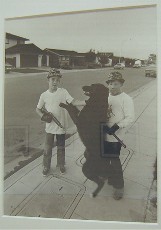
I also caught the Bill Owens photographs of suburbia from the same era at James Cohan Gallery. The differences in intent between Owens and Eggleston are dramatic. Owens is not about the people as individuals but rather as suburban archetypes. The work is satiric and not always so kind. He’s all about human social structures and the values that underlie the activities and possessions (image, “Untitled (Boys with guns and dog),” 1972).
Other notable images include a McDonald’s, a Fourth of July parade, and a group of couples in their 50s posing in a hot tub.
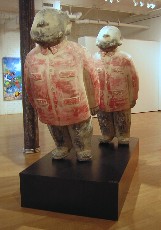
An art trip, to be truly successful for me, requires a little serendipity. I wandered into a gallery I had by passed before, Plum Blossoms Gallery, just because it was open. The work is Asian or has some Asian connection.
This large fiberglass sculpture, “China China” by Zhu Wei, comments on conformity and uniformity. But it also brings in a cartoon quality, in which the portly burghers-of-China meet Micky Mouse charm. All right, so the concept of burghers in a communist state is oxymoronical. But there’s a conservatism to the figures, even if their conservatism is pro-Communist. Zhu is from Beijing.
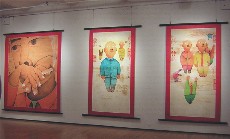
Zhu also created these giant scrolls that have an advertising feel and that also give the humanity a touch of cartoon foolishness. The drawing is again charming cultural satire, the figures taking on a helium-filled floatiness, the paint thin and delicately colored. What I love about these paintings and the sculptures is their kind generosity to the people depicted, a clear sense of love, even at the same time that the artist is having a little laugh at them (left, “Sketch, No. 1,” middle, “The Heavenly Maiden Scattering Flowers, No. 38” and right, “The Heavenly Maiden Scattering Flowers, No. 39”.
Zhu walks a line between the past and the present. Using a commercial sign style that refers to a scroll is pretty radical and conventional at the same time. Also, in the sculpture, he’s apparently referring to the buried terra cotta army at the same time that he’s making cartoon-like figures that remind me of Botero and parade balloons.
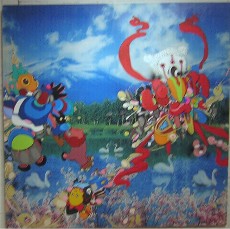
Also in the show, Brooklyn-based Toby Barnes’ “We like the blossoms, the blossoms that go ‘bloom'” is painted on a cheesy scenic shower curtain. Barnes is half Japanese, and the figures have the E.T. manga thing going, but without the shower curtain, I don’t think this work is entirely unexpected. However, it’s fun to look at and I have to give it lots of extra points for the title.
Also in the futurist invasion-of-the- blob category is “Shadowless,” four little biosphere domes on legs by Unmask. The domes contain scenarios with rubbery-looking creatures and/or trekkie-type humans. The weirder and more mutant-looking these are, the better I like them.
Also in the show are satirical paintings by Wei Dong, using a traditional Chinese look to create a kind of morality play in paint. One piece is called “The Law Enforcer,” for example. She does not look like a nice person. Nor does “The Ambitious Lady.” Also in the show are some traditional, gestural Asian nature paintings with a Western minimal influence by Hon Zhu An, and a series of sculptures made of Euros by Wu Shaoxiang, for example a red map of China topped by a gold hammer and sickle, that earned an initial grunt of appreciation.
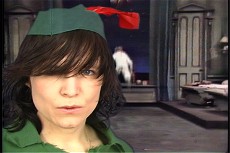
My last stop was supposed to be John Connelly Presents, but I missed half the show. However, in the spirit of Peter Pan buses, this video by Tara Mateik deserves a mention. This is an all women’s show, supposedly, but Tara, who plays the role of Peter, is neither here nor there on the gender scale (but I’d call her a he until informed I’ve got it wrong, given the shape of the body and other stuff I’ve read about him). Anyway, Peter Pan dances to Michael Jackson music with some Michael Jackson moves and with that weird Michael Jackson sexual ambiguity. I thought it was pretty hilarious.
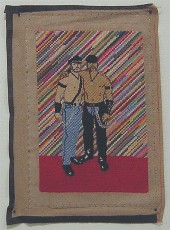
Here’s another piece from the show, stitchery by Maria Pineres, “Bobby and Tim.” As far as I know, Maria is a woman. The guys are such a pair of guys they steal the image from her and practically become the artist, the maker of their own image. Others in the show include Laura Anderson Barbata, Fiona Banner, Anne Collier, Camille Norment, Josephine Meckseper, Marilyn Minter, Aleksandra Mir, Kati Heck, Laura Parnes, Goody-B.Wiseman, and Sherry Wong. (image, “Bobby and Tim,” cotton thread on canvas, image 12 x 8 inches, cavas 16 1/2 x 11 1/2 inches).
Alas, I missed some of the show. The humidity must have addled my brain.









